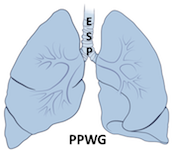Currently, the firm diagnosis of pulmonary AMR is based on the ''triple test''
approach, previously proposed by the Pathology Council of the ISHLT in 2012 (1,2).
This means, ideally, the diagnosis of AMR should be based on the presence of
clinical allograft dysfunction, circulating donor-specific antibodies and
pathologic findings.
Immunological screening information is an essential tool to help in
the diagnosis of lung AMR and medical professionals in this field
should be acquainted with the basic tests available to enable the
timely diagnosis of such a potentially life-threatening process as
AMR can occur even in the presence of low levels of circulating
donor-specific antibodies (3,4).
Patients presenting with a clinical or histological picture compatible
with a suspicion of lung AMR should undergo the following fundamental
immunological investigations:
1) A basic immunological screening to determine whether such patient
presents an elicited anti-HLA antibody response. Such assay is generally
based either on a flow cytometric or luminex platform (5).
2) In case of a positive screening test result, further investigations
should be carried out to determine the specificity of such an elicited
anti-HLA antibody response. Indeed, at this stage for the diagnosis of
AMR it appears critical to determine whether such an elicited anti-HLA
antibody response is donor-specific or not . The possible initiation of a
specific treatment will be based on the results of the assay that is
generally based on a luminex platform (5).
While the reasoning behind the necessary immunological investigations
is pretty straightforward, the technologies involved require dedicated
laboratory equipment and specifically trained immunological staff who are
familiar with the methodologies but also with the interpretation of the results.
Indeed such analyses may in some cases be rather challenging, possibly
requiring additional assays. Furthermore, clinicians should be reminded
that there is now evidence at least for other organs, that transplant
AMR may be elicited by non-HLA antibodies that will not be picked up
by conventional immunological screening (5,6).
In conclusion, lung AMR represents a potentially life-threatening
clinical condition whose diagnosis can be quite challenging. In this
context, the patient’s immunological evaluation represents an essential
part of the diagnostic algorithm and should always be available to enable
timely diagnosis and possible treatment of such a serious complication
in a lung allograft recipient.
Pitfalls
Very low levels or even the complete absence of donor-specific
HLA-antibodies does completely rule out the existence of AMR.
Indeed, clinicians should be aware that the following unexpected
situations may occur:
- Due to assay interferences, a prozone effect may strongly
reduce the mean fluorescence intensity (MFI) of one or more antibodies
impacting on the ultimate assay read out and interpretation (7).
- The AMR process may be driven by non-HLA specific antibodies (8).
Emanuele Cozzi (Transplant immunologist, University Hospital of Padova, I)
References :
1. Stewart S, Fishbein MC, Snell GI et al. Revision of the 1996 working formulation for the standardization of nomenclature in the diagnosis of lung rejection. J Heart Lung Transplant. 2007 Dec;26(12):1229-42.
2. Berry G, Burke M, Andersen C, et al. Pathology of pulmonary antibody-mediated rejection: 2012 update from the Pathology Council of the ISHLT. J Heart Lung Transplant. 2013 Jan;32(1):14-21.
3. Westall GP1, Paraskeva MA, Snell GI. Antibody-mediated rejection. Curr Opin Organ Transplant. 2015 Oct;20(5):492-7.
4. Chin N, Westall G, Paraskeva M et al.Challenges inherent to the diagnosis of antibody-mediated rejection in lung transplantation. Respirol Case Rep.2015 Mar;3(1):36-9.
5. Tait BD, Süsal C, Gebel HM, Nickerson PW, Zachary AA, Claas FH, Reed EF, Bray RA, Campbell P, Chapman JR, Coates PT, Colvin RB, Cozzi E, Doxiadis II, Fuggle SV, Gill J, Glotz D, Lachmann N, Mohanakumar T, Suciu-Foca N, Sumitran-Holgersson S, Tanabe K, Taylor CJ, Tyan DB, Webster A, Zeevi A, Opelz G. Consensus guidelines on the testing and clinical management issues associated with HLA and non-HLA antibodies in transplantation. Transplantation. 2013 Jan 15;95(1):19-47.
6. Giral M1, Foucher Y, Dufay A, et al. Pretransplant sensitization against angiotensin II type 1 receptor is a risk factor for acute rejection and graft loss. Am J Transplant. 2013 Oct;13(10):2567-76.
7. Schwaiger E, Wahrmann M, Bond G, Eskandary F, Böhmig GA. Complement component C3 activation: the leading cause of the prozone phenomenon affecting HLA antibody detection on single-antigen beads. Transplantation. 2014 Jun 27;97(12):1279-85.
8. Sigdel TK, Sarwal MM. Moving beyond HLA: a review of nHLA antibodies in organ transplantation. Hum Immunol 2013; 74: 1486-90.


